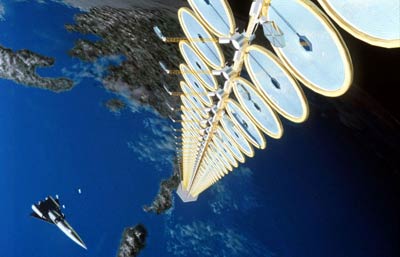
So a couple of pentagon think tankers were kicking the old peanut around and came up with an interesting idea. Space based solar energy. This is not a new idea.
Recently, officials with the U.S. Department of Defense (DoD) announced that scientists and other personnel at the National Security Space Office (NSSO) of the U.S. Pentagon might study SSP in the future with the idea of using satellites to collect solar energy for use on the Earth.
For this idea to work, space-based satellites in orbit around the Earth would need to be in geosynchronous orbits (that is, an orbit that has the same orbital period as the Earth so that an observer on the ground would see the satellite fixed at one location above him) or sun-synchronous orbits (that is, the satellite would always face the Sun so that the satellite passes over a given point on the Earth’s surface at the same time with respect to the Sun).
…
Such a SSP system would use photovoltaics (PV) to convert energy from the Sun. PV technology consists of solar cells to convert solar energy into electricity. Then, energy collected from the Sun would be transmitted to the Earth with the use of microwave technology. Microwaves are electromagnetic waves with wavelengths in the range between 30 centimeters and one millimeter. The use of microwaves is commonly found in kitchen microwave ovens.
(via)
I wonder if they would try and turn this into some sort of space based solar death ray? Never mind that NASA did a study like this in 2000 and found that it would be pretty damn hard to do.
The nine-month-long study looked at the market for electricity from the present to the year 2020, roughly the year when many experts believe satellite solar power actually could be possible. Included were comments from the Electric Power Research Institute and Texaco.
Among the findings:
* Conventional electricity generation in both developed and developing countries may be more than adequate in terms of cost, supply and environmental factors.
* Satellite solar power is relatively immature technology. That makes it difficult to estimate costs and the likely competitiveness of such an idea measured against other energy systems.
* Lower launch costs could help make satellite solar power more promising. But until those costs go down, it is too early for the U.S. government to commit to related loan guarantees or tax incentives.
* Health risks associated with exposure to electric and magnetic fields generated by satellite solar power are likely to be of significant public concern.
* Such power may be useful for the International Space Station, moon bases or other space missions.(via)
Basically this is like the hydrogen economy, something that will always be 30-50 years in the future. What really needs to happen is the development of renewable sources that are a little more “down to earth” that is further developments in solar panels, wind turbines, and energy storage technology.
Luckily not everyone in the military is thinking so far ahead. The California Air National Guard is switching to solar power for the operation of its armory in Fresno. The Guard hired MCC Construction and Akeena Solar, already one of the state’s biggest residential installer of solar systems, to do the multimillion-dollar job.
Many government agencies are discovering that there never has been a better time to switch to solar, avoiding volatile and increasingly high prices for conventional energy sources. The first phase of the Fresno system will produce the equivalent of the power used by 34 average households. By the time the entire system is finished, it will produce the equivalent of power used by 100 households.
Barry Cinnamon, CEO of Akeena, stated, “We are thrilled to be showcasing Akeena’s design and integration talents in the Central Valley of California. The hot climate and high electricity rates have been the driving force behind the astounding growth for the solar power industry in this region. We are happy to work with California Air National Guard base to produce clean renewable power while helping the base to save money.â€